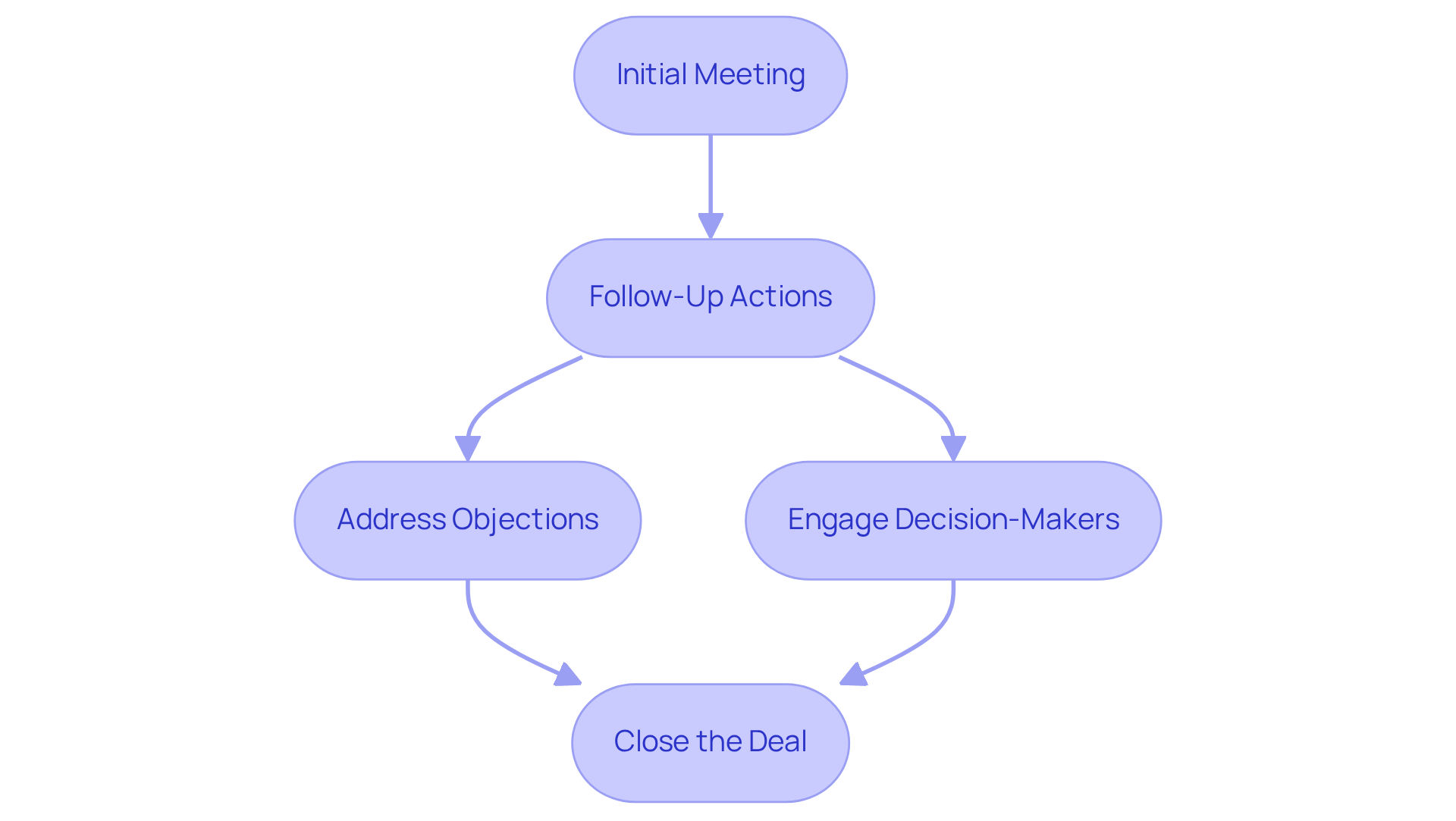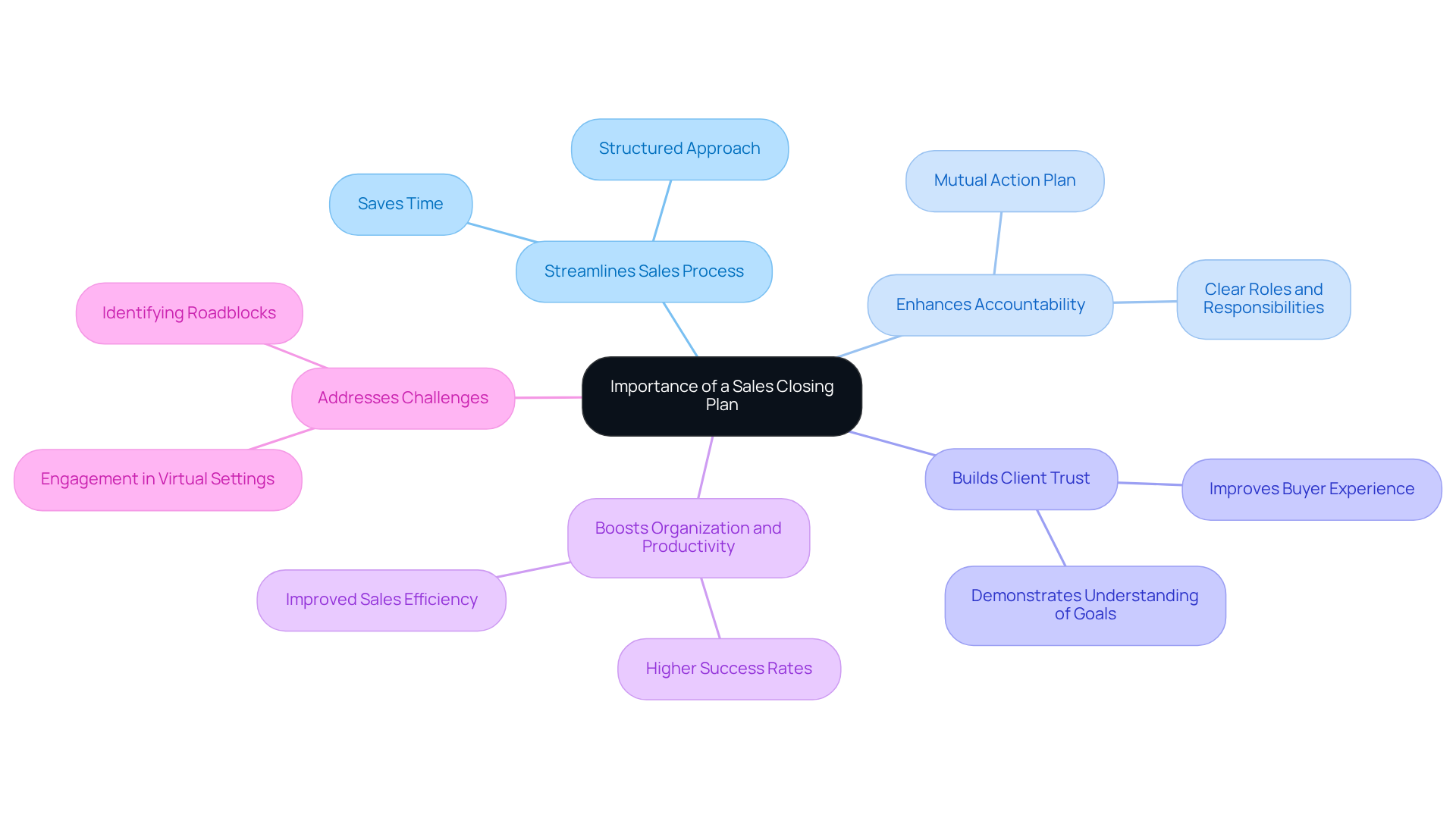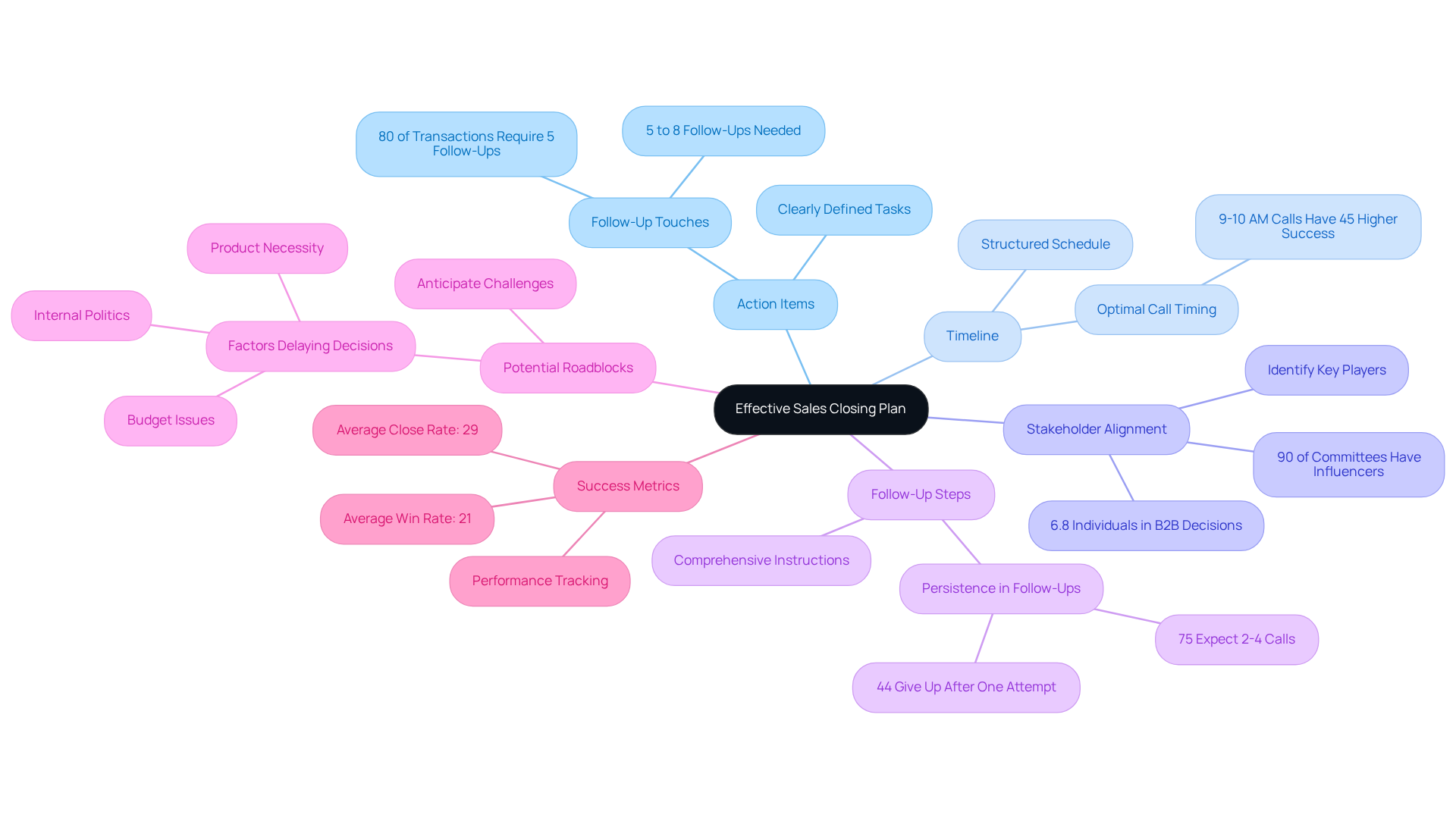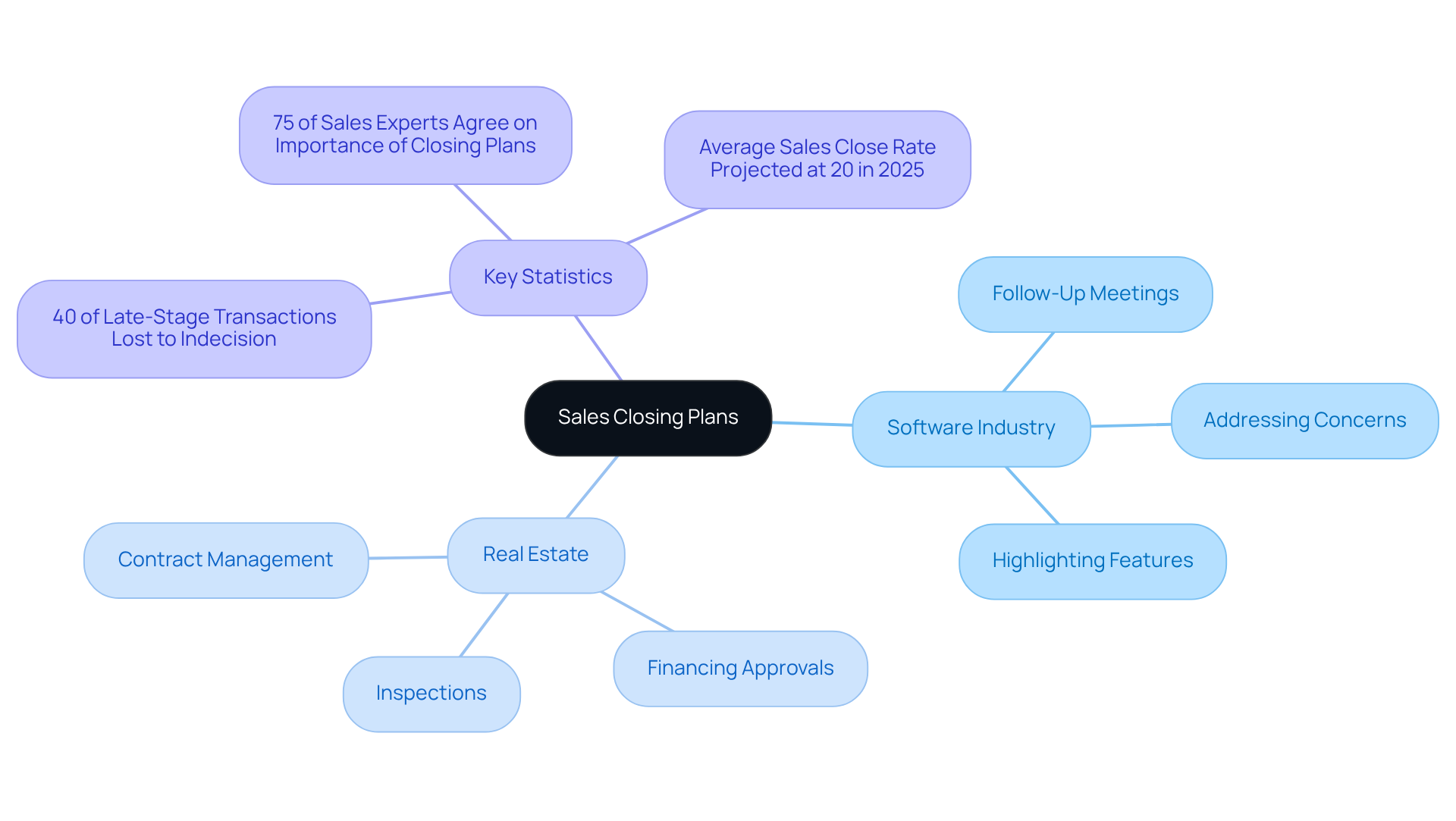
Overview
You might be wondering why a sales closing plan is so crucial. Well, let’s chat about it! This article dives into the key components and importance of having a structured approach when finalizing sales. Think of it this way: organized closing strategies not only enhance communication but also boost your follow-up effectiveness. And who doesn’t want to see those success rates climb?
By providing clarity and accountability throughout the sales process, a solid closing plan can be your best friend. It’s like having a roadmap that guides you and your team toward the finish line. So, if you’re looking to wrap up those sales more effectively, this is definitely something worth exploring further!
Key Highlights:
- A sales closing plan, or deal strategy, is a structured document that outlines steps needed to finalise sales, enhancing communication and success rates.
- 80% of successful transactions require five or more follow-up calls, emphasising the need for a clear closing strategy.
- Key components of an effective closing plan include action items, timelines, stakeholder alignment, follow-up steps, potential roadblocks, and success metrics.
- Structured closing strategies can boost organisation and productivity, resulting in higher success rates, especially in competitive markets.
- In the software industry, follow-up meetings are tailored to address specific client concerns, while real estate agencies coordinate steps for property transactions.
- Statistics show that 40% of late-stage transactions are lost due to indecision, highlighting the importance of organised follow-ups.
- The average close rate across industries is projected to be around 20% in 2025, with specific sectors like Computer Software reaching 22%.
Introduction
Crafting a successful sales closing plan is super important in today’s competitive marketplace, right? Clarity and organization can really make or break a deal. This strategic framework doesn’t just help streamline the process of finalizing agreements; it also boosts communication among team members and clients alike. But here’s the thing: many sales teams struggle to keep that engagement and accountability up.
So, what are the key components that can take a basic closing strategy and turn it into a powerful tool for success?
Let’s dive into the details of an effective sales closing plan, and uncover not just why it matters, but also some practical steps that can lead to better performance and stronger client relationships.
Define Sales Closing Plan: Key Concepts and Purpose
You might be wondering, what exactly is a sales agreement strategy? Well, it's often called a deal strategy, and it's basically a structured document that lays out the essential steps and actions needed to seal the deal. Think of it as your roadmap for success! This strategy guides representatives, detailing follow-up actions, identifying potential roadblocks, and ensuring everyone involved is on the same page. The main goal here is to simplify the finalization process, boost communication, and ultimately enhance the chances of wrapping up a deal successfully.
Did you know that data shows 80% of successful transactions require five or more follow-up calls after the first meeting? This really underscores the importance of having a clear strategy in place. By providing clarity and direction, a solid strategy for finalizing transactions helps teams navigate the complexities of closing agreements with ease.
Now, let’s dive into what a well-organized transaction finalization plan might look like. It can include:
- Specific timelines for follow-ups
- Detailed responses to anticipated objections
- Strategies for engaging decision-makers
Industry leaders back this up too! As Anthony Iannarino puts it, "Organizing your sales conversation enhances the chances of achieving a successful interaction, and it showcases to your ideal client your professionalism." This really highlights how a thoughtful approach to closing can make a big difference in outcomes.
And here’s a fun thought: including motivational quotes can really keep the team's spirits high! Zig Ziglar once said, "People often say that motivation doesn’t last. 'Well, neither does bathing—that’s why we recommend it daily.'" This is a great reminder of how important consistent motivation is in our efforts.
In summary, a sales closing plan isn't just a checklist; it's a comprehensive strategy that boosts the effectiveness of your sales efforts, leading to higher conversion rates and stronger client relationships. Without such a strategy, sales teams might run into issues like miscommunication and missed opportunities. So, it’s clear that organized finalization strategies are crucial for success!

Explain the Importance of a Sales Closing Plan in Sales Strategy
You might be wondering just how important a closing plan is in your business strategy. Well, it’s pretty crucial! Think of it as a roadmap that helps streamline your sales process by laying out the steps needed to seal the deal. This organized approach reduces confusion and miscommunication among your team and your clients. Plus, having a solid final strategy keeps everyone accountable, ensuring that everyone knows their roles and responsibilities. That kind of clarity builds trust with clients and boosts your chances of landing those high-value deals that are essential for growing your revenue.
In today’s competitive landscape, a well-thought-out final strategy can be the game-changer that sets successful teams apart from the rest. Teams that embrace structured finalization strategies often see a boost in their organization and productivity, leading to higher success rates. For instance, did you know that the computers and electronics sector has an average success rate of 23%? And here’s a fun fact: 84% of business buyers value the experience just as much as the product itself. So, a thoughtful closing strategy can really enhance the buyer experience, strengthening those client relationships and driving sales.
Now, let’s not forget about the challenges we face. A significant 19% of participants see engagement in virtual settings as a major hurdle. This highlights just how vital a well-organized closing strategy is. As someone once said, 'A sales strategy can simplify your finalization process, particularly with valuable prospects you want to retain.' So, let’s dive into how you can make your closing strategies work for you!

Identify Key Components of an Effective Sales Closing Plan
So, you’re looking to perfect that sales closing plan, right? Well, let's break down some key components that can really drive your success:
- Action Items: First off, you need clearly defined tasks to keep the deal moving forward. Did you know that securing a conversion usually takes about 5 to 8 follow-up touches? Yep, and 80% of transactions need at least 5 follow-ups. That’s why having detailed action items is super important.
- Timeline: Next up is a structured schedule. When should you execute those action items? Research shows that sales calls made between 9 and 10 a.m. have a whopping 45% higher chance of success. So, timing your follow-ups is key!
- Stakeholder Alignment: Now, let’s talk about who’s involved in the decision-making process. You’ll want to identify all the key players to make sure everyone is on the same page. Fun fact: there are usually about 6.8 individuals involved in B2B decisions, and 90% of decision-making committees say one member often tries to influence the final call. Keeping everyone aligned is crucial!
- Follow-Up Steps: What happens after you interact with the client? You need comprehensive instructions on how to engage with them next. Here’s a kicker: 80% of sales require at least 5 follow-ups, but 44% of sales reps give up after just one attempt! Plus, 75% of consumers expect 2 to 4 phone calls before they write off a potential deal. Persistence is definitely key here.
- Potential Roadblocks: Let’s not forget about the challenges that might pop up during the finalization process. Anticipating these roadblocks and having strategies to tackle them can make a world of difference. Understanding what might delay decisions—like product necessity, budget issues, or internal politics—can help you craft effective responses.
- Success Metrics: Lastly, you’ll want to set standards for measuring how well your closing strategy is working. Keeping track of performance metrics can really enhance your strategies and boost your win rates. On average, win rates sit around 21% across industries, with the average close rate in 2023 being 29%.
By weaving these components together, sales teams can develop a strong sales closing plan that not only boosts their chances of success but also makes the sales process more organized and efficient. So, what do you think? Ready to dive in and refine your approach?

Provide Examples of Sales Closing Plans in Action
You might be wondering why a sales closing plan is considered such a big deal across different sectors. Well, they really show off their flexibility and efficiency! Take the software industry, for instance. A company there might set up a series of follow-up meetings with potential clients. These meetings are carefully crafted to tackle specific concerns, highlight product features, and reinforce the value proposition, all aimed at guiding prospects toward making a decision.
Now, let’s dive into the real estate world. Agencies often roll out finalization strategies that lay out the essential steps for wrapping up property transactions. This means coordinating inspections, securing financing approvals, and managing contract signings. It’s all about keeping everyone in the loop and engaged throughout the process.
By looking at these practical examples, teams can gain some valuable insights into how to tailor their own final strategies. For example, did you know that a study found 40% of late-stage transactions get lost because of indecision? That really highlights how important organized follow-ups and clear communication are in the context of a sales closing plan. Plus, 75% of sales experts agree that having an efficient sales closing plan significantly boosts their success rates.
Customizing final strategies to fit specific sales environments not only simplifies the process but also is a crucial part of an effective sales closing plan that helps build stronger connections with clients. This ultimately leads to better sales outcomes. And here’s a fun fact: the average sales close rate across industries is projected to be around 20% in 2025, with sectors like Computer Software hitting a close rate of 22%. Incorporating these stats can really help paint a clearer picture of how effective closing plans can be in various contexts.

Conclusion
A sales closing plan isn’t just a checklist; it’s a strategic framework that’s essential for navigating the tricky waters of finalizing deals. You might be wondering how it helps—well, it provides a structured approach that enhances communication, accountability, and ultimately boosts your chances of success in those sales transactions. The importance of having such a plan can’t be overstated; it streamlines the sales process and builds stronger relationships with your clients.
Throughout this article, we’ve looked at key elements of an effective sales closing plan, like:
- Clearly defined action items
- Structured timelines
- Stakeholder alignment
- Strategies to tackle potential roadblocks
These components come together to form a cohesive strategy that not only ramps up productivity but also significantly improves conversion rates. Plus, real-world examples from various industries show just how flexible and effective tailored closing plans can be, highlighting the need for organized follow-ups and clear communication.
Embracing a well-crafted sales closing plan can truly transform your sales team. In today’s competitive landscape, the ability to close deals efficiently can really set successful teams apart. By putting into practice the insights we’ve discussed, you can enhance your strategies and ultimately drive better results. So why wait? Taking action now to refine your closing strategies will pave the way for sustained success and stronger client relationships in the future.
Frequently Asked Questions
What is a sales closing plan?
A sales closing plan, also known as a deal strategy, is a structured document that outlines the essential steps and actions needed to finalize a deal. It serves as a roadmap for success, guiding sales representatives through the process.
What is the main purpose of a sales closing plan?
The main purpose of a sales closing plan is to simplify the finalization process, boost communication among team members, and enhance the chances of successfully closing a deal.
Why is follow-up important in the sales process?
Data shows that 80% of successful transactions require five or more follow-up calls after the first meeting. This highlights the importance of having a clear strategy in place to guide follow-up actions.
What elements might be included in a sales closing plan?
A well-organized sales closing plan may include specific timelines for follow-ups, detailed responses to anticipated objections, and strategies for engaging decision-makers.
How can a structured sales conversation impact outcomes?
Organizing the sales conversation enhances the chances of achieving successful interactions and demonstrates professionalism to clients, as emphasized by industry leaders like Anthony Iannarino.
What role does motivation play in sales closing?
Consistent motivation is important in sales efforts, as it helps maintain team spirits. Including motivational quotes can serve as a reminder of the need for ongoing encouragement.
What are the consequences of not having a sales closing plan?
Without a sales closing plan, sales teams may face issues such as miscommunication and missed opportunities, ultimately hindering their effectiveness and success in closing deals.
👍
What others are liking
5 Steps to outline your ideal documentation structure
5 MINS READ
Where to start the your journey of mapping out your ideal documentation structure, aligning it with the very heartbeat of your organization?
Defining a winning level of detail in your process
3 MINS READ
What is too much detail, and what is too little? This article described in that winning level detail about what detail is enough.





